PART I - METHODOLOGICAL ISSUES
Published online by Cambridge University Press: 05 June 2012
Summary
The two chapters in this section, both published in 1993, illustrate the importance of the meetings of the International Society for History, Philosophy, and Social Studies of Biology (ISHPSSB) as a vehicle for interdisciplinary communication. Chapter 2 was first presented in 1991 at an ISHPSSB symposium, which Muriel Lederman and I co-organized, on “the right organism for the job.” The papers from the symposium were published as a special section of the Journal of the History of Biology (Lederman and Burian 1993). The symposium was inspired in part by an earlier symposium organized by Adele Clarke and Joan Fujimura, held at the 1989 ISHPSSB meeting and later expanded into a book titled The Right Tools for the Job (Clarke and Fujimura 1992). Chapter 3 was originally presented at another 1989 ISHPSSB symposium on the importance and difficulty of integration and unification in the biological sciences. The methodological and epistemological issues at the center of all three symposia received wide attention.
The symposium on model organisms focused on a distinctively biological topic in scientific methodology. Experimental work often requires development of an experimental system (Rheinberger 1995, 1997, 1998). In biology, it often depends as well on the domestication and development of an organism especially suited to the problems at hand. For example, when biologists were limited mainly to breeding experiments and conventional forms of microscopy in studying genes, the relationship of genes to chromosomes could be studied in detail only in organisms with a small number of chromosomes that were easily visualized in standard microscopes and relatively easy to distinguish from one another.
- Type
- Chapter
- Information
- Publisher: Cambridge University PressPrint publication year: 2004

